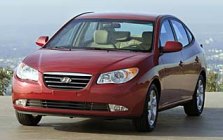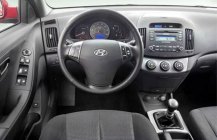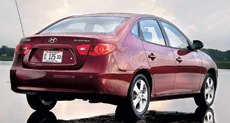|
 The
outgoing Elantra was one of the worst cars in the class. It looked ugly
and performed poorly in engine refinement, handling and especially ride
quality. If not the low price, its credit rating would have been set at
junk level. Having such a poor predecessor, the new car (called Avante
in Korea) should have an
easier life. It won't be difficult to get favourable comments from
motoring journalists such as "a huge improvement here, a big
improvement there". The question is, can the largest Korean car maker –
or the 6th largest car maker globally – produce something really
competitive against the best Japanease and European small cars without
resorting to aggressive pricing ? after the recent Sonata and Azera,
there seems to be a good chance. The
outgoing Elantra was one of the worst cars in the class. It looked ugly
and performed poorly in engine refinement, handling and especially ride
quality. If not the low price, its credit rating would have been set at
junk level. Having such a poor predecessor, the new car (called Avante
in Korea) should have an
easier life. It won't be difficult to get favourable comments from
motoring journalists such as "a huge improvement here, a big
improvement there". The question is, can the largest Korean car maker –
or the 6th largest car maker globally – produce something really
competitive against the best Japanease and European small cars without
resorting to aggressive pricing ? after the recent Sonata and Azera,
there seems to be a good chance.
At the first glance, the new Elantra is not very promising. Why?
Because its organic exterior design looks outdated and characterless.
Who knows why Hyundai demonstrated so many HCD blah blah blah concept
cars through the years and still resulted in production cars looking
this boring. Open the doors, similar harsh words can be said to the
design of the dashboard. However, at least the materials are far better
than you expected for Korean cars. There are real-looking faux alloy
and brush aluminum panels. The plastics are no longer shinny ones, but
fully textured, if not soft-touching. The dials and displays illuminate
in blue. All these features appear to be Japanese style. Not bad.
 Better
still is space and comfort. The Hyundai compact car measures 2650 mm in
wheelbase, 1775 mm in width and 1480 mm in height. This give it more
generous room than all Japanese rivals, Honda Civic sedan and Nissan
Sentra included. The amount of shoulder room, head room, legroom and
foot room are so generous that the USA's EPA classified it as mid-size
car instead of compact ! All seats are mounted high and are very
comfortable, if they don't look as good. The driver seat is served with
height adjustment and telescoping steering wheel, so drivers of any
size can find comfortable driving position. Better
still is space and comfort. The Hyundai compact car measures 2650 mm in
wheelbase, 1775 mm in width and 1480 mm in height. This give it more
generous room than all Japanese rivals, Honda Civic sedan and Nissan
Sentra included. The amount of shoulder room, head room, legroom and
foot room are so generous that the USA's EPA classified it as mid-size
car instead of compact ! All seats are mounted high and are very
comfortable, if they don't look as good. The driver seat is served with
height adjustment and telescoping steering wheel, so drivers of any
size can find comfortable driving position.
The Elantra is a 4-door sedan with a rather short trunk, so its luggage
room measures only 402 liters, not much bigger than most hatchbacks.
Open the trunk lid and you will see where Hyundai saves money – the
interior of the trunk is the bare chassis without any fabric or plastic
covering. The old-fashioned hinges of the trunk lid intrude seriously
into the luggage space. Hyundai hides the cheap stuffs in where you
rarely notice. This give us an impression that the car is not really
that well built.
 The
Elantra offers 3 engines to choose from: 120hp 1.6-liter DOHC CVVT,
138hp 2.0-liter DOHC CVVT and 115hp 1.6-liter 16V common-rail turbo
diesel. The diesel is designed for Europe while the largest petrol
engine targets mainly at American. The 2.0-liter is an old engine that
served the outgoing Elantra. It is neither powerful nor frugal despite
of the variable valve timing. Cast iron block fails to suppress its
noise, which becomes intrusive above 3500 rpm even though the new cabin
is better insulated. That makes highway driving unpleasant. On the
positive side, the 5-speed manual has a smooth gearshift and a delicate
clutch pedal. Another transmission is an old-fastioned 4-speed
automatic. It takes some performance off, but the gearing keeps engine
rev low at cruising, thus deliver better refinement than the manual. The
Elantra offers 3 engines to choose from: 120hp 1.6-liter DOHC CVVT,
138hp 2.0-liter DOHC CVVT and 115hp 1.6-liter 16V common-rail turbo
diesel. The diesel is designed for Europe while the largest petrol
engine targets mainly at American. The 2.0-liter is an old engine that
served the outgoing Elantra. It is neither powerful nor frugal despite
of the variable valve timing. Cast iron block fails to suppress its
noise, which becomes intrusive above 3500 rpm even though the new cabin
is better insulated. That makes highway driving unpleasant. On the
positive side, the 5-speed manual has a smooth gearshift and a delicate
clutch pedal. Another transmission is an old-fastioned 4-speed
automatic. It takes some performance off, but the gearing keeps engine
rev low at cruising, thus deliver better refinement than the manual.
The chassis is 49 percent stiffer than the old car, which helps ride
quality and refinement. Its handling is slightly better than Toyota
Corolla and Nissan Sentra, but the ride is too floaty at higher speed
and the electric power steering is too light and numb to challenge the
best European and Japanese rivals, namely Volkswagen Golf, Ford Focus,
Mazda 3 and Honda Civic. In short, this is not a driver's car.
The bottom line is: the new Elantra is a big improvement from the old
car, just as you might have read from other journalists. Its cabin
space and seat comfort are particularly impressive. Nevertheless, no
matter in dynamics or refinement, there is still a long way to go
before it can match the class leaders. Until then, its trump card is
still the keen price and long list of standard equipment. |